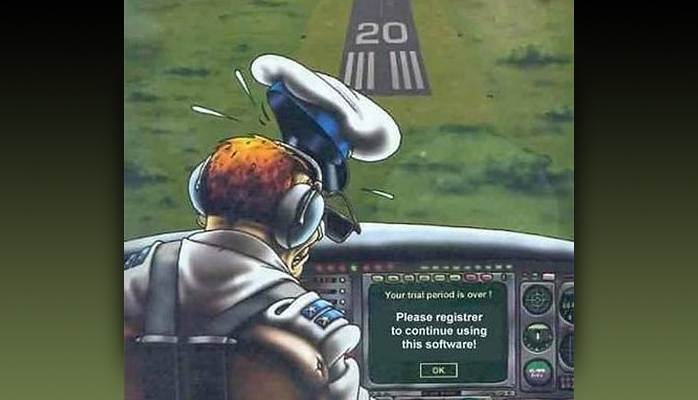Dying to Embrace Automation
On an intellectual level, I am 100% in favor of technology, and the benefits which technology affords everyone, every day. On a practical level regarding aviation though, OEM’s developing technology just to have products to sell is creating more problems than it is curing. FMS’s and iPhones are not the same thing, even if the marketing is.
In aviation, an industry that screams technology, it only stands to reason that there are many wonderful and helpful advances in all categories of automation. At what point however, does automation stop helping and start hindering safety?
I believe we are currently at a point where more technology and the pressing theme to embrace automation is no longer helpful. And makes even less sense when all the new technology/products are doing is replacing last year’s automation with this year’s automation with a new name.
It is my opinion that most technology is no longer adding anything new in the way of meaningful advancements. Planes fly the same way planes flew back when I was flying (in the 70’s, 80’s, & 90’s). And we made it work with much more reliably than with today’s over-the-top automation. We did not depend on, nor embrace automation much beyond altitude-hold on a long trip. We actually knew how to fly, and more importantly we knew how to “hand-fly”.
How many pilots today can fly a “back course” by hand, or even know what a “back course approach” is? How about an ADF approach, how about simply “hand-flying” a visual approach to a landing without a computer?
Here is the kind of thing we did for practice/fun. When coming into a destination, instead of typing in all of the information for the arrival an hour before we got there, we “hand-flew” the arrival. We clicked off the auto-pilot and “hand-flew” from the first descent into the terminal area from 41 or 39 thousand feet. The PIC would set power at that point and see if he could get all the way to the fence without ever touching the power again, hand flying and controlling all of the speeds, altitudes, and ILS to a landing.
We did this all the time and with rare exceptions. Maybe a major traffic delay now and then, otherwise the power settings were never changed until the throttles were closed for landing. Those are piloting skills. Typing into a computer is not a piloting skill; following the magenta line is not a piloting skill. This also allowed us to look out the very decidedly low-tech window.
I know having one pilot looking out the window is not very high tech, but looking out the window might save a lot of problems. We were looking out for obstructions like birds and other aircraft, aka, “deal-killers”.
I remember a few years ago the TV was frantically telling me about a “heroic” airline pilot (who had just taken off) from LaGuardia in a brand new airliner. Who within minutes had dumped it into the Hudson River.
How exactly does a brand new state-of-the-art jet airliner wind up in a river?
Maybe, and I am just saying maybe, this experienced crew, at low altitude, in an airport terminal area, had their collective heads up their collective butts typing, reading, and embracing automation and not looking out the friggin’ window!
Remember, birds do not fly in the clouds, so they had to be in the clear and easily seen if anyone was looking.
If at least one of these “airmen” had been looking out the “low-tech” window, that information in the NOTAMS describing migrating bird activity (in said airport terminal area) might have been helpful, assuming they ever read it. Yes, these “heroes” flew right into a flock of birds the size of a freight train which totally trashed both engines to the point where returning to the airport was not an option.
Had one of the two airmen not been totally engaged in embracing automation, but doing just a bit (of old fashion “hand-flying”) and looking out the very low-tech window, they might have seen that huge flock of birds in time to miss them or least pull the power back to limit the damage to the engines.
Had that flight gone out of JFK instead of LaGuardia and wound up in the ocean, the ending would have been a whole lot different. The ocean is not nearly as forgiving as a 7 mile long, mile-wide river on a calm day.
Recently there was an accident involving a small plane and a helicopter. It turned out the small plane was loaded with high-tech computer equipment. I am betting that had the pilot been looking out the window and not trying to figure out what the computer was doing, this fatal accident would never have happened.
Last week another Asian aircraft went down, and from what we know about it at this time, the pilot asked for a deviation due to weather, but ATC denied the request. The result ended in a debris field in the middle of the ocean. Back when I was flying if I asked for weather deviation due a thunderstorm in front of me, I got it. That was because I did not allow ATC to tell me “No” when I knew I needed to make a “PIC” decision that involved safety. I just told them to “deal with it” which they always did because the “PIC” is the “PIC” and is responsible for the aircraft, not some ATC guy in a recliner!
But again, here we are all caught up in automation. And pilots not being pilots and taking charge when they need to, but going with the program, and becoming statistics.
Automation is fine but it cannot and does not replace pilots, hand-flying skills, and pilot knowledge. It is time for the industry to wake up! As Paul Harvey used to say “Not all that’s called progress IS progress.
Erudite Solutions for Business Aviation

